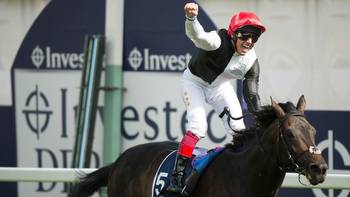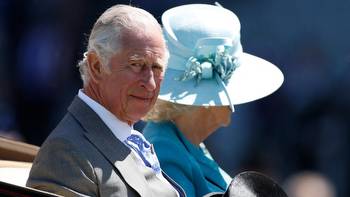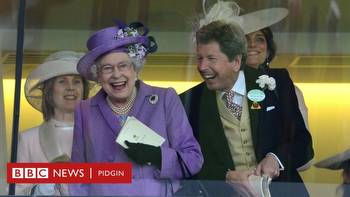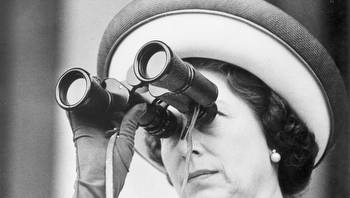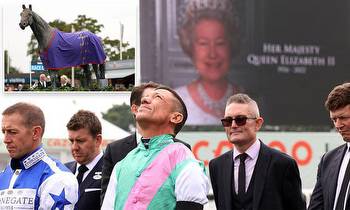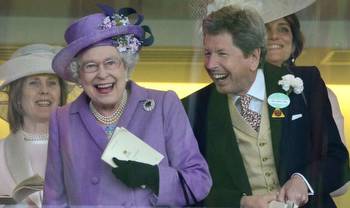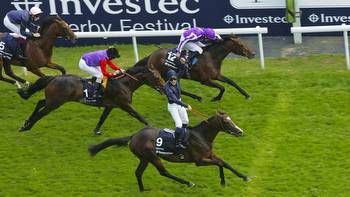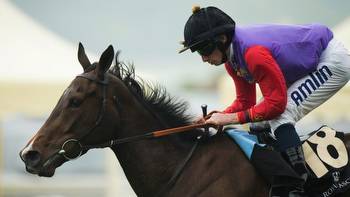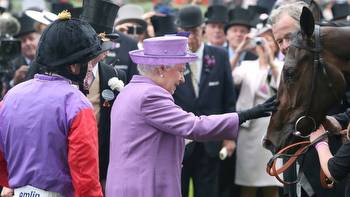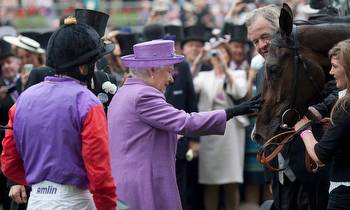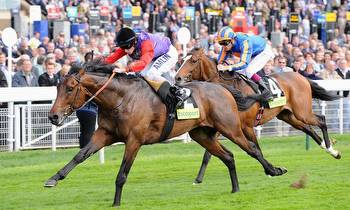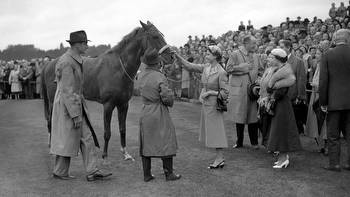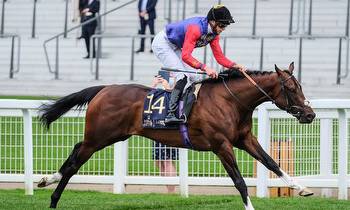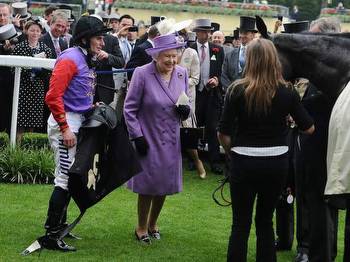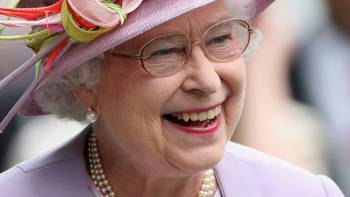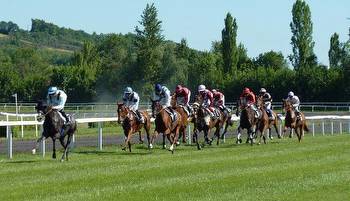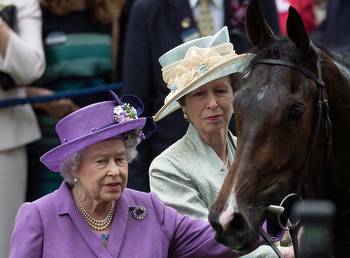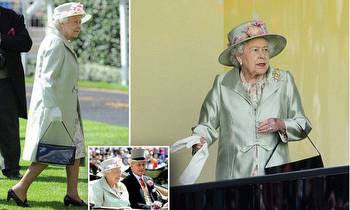Platinum Jubilee: Royal approval has been such a boon for racing

Whether she is able to be there or not, it seems doubtful that Her Majesty The Queen would rather be anywhere else than the Surrey Downs on the first Saturday in June, watching a race that has thrilled and at times tormented her for the past seven decades.
With Derby Day falling during a weekend of nationwide celebrations, it promises to be quite like no other with Her Majesty, or representative, set to be greeted by 40 jockeys who have ridden for her all dressed in her famous silks, while several of her former racehorses will also be on parade.
There will also be a special interactive display on The Hill in recognition of Her Majesty’s love of the thoroughbred with virtual reality headsets, equicizers and the chance to interact with a number of racehorses up close.
Sadly, there will be no Royal runner in the great race itself, meaning The Queen’s quest to win the Derby will go on for at least another year. She has still never come closer to winning the great prize than in 1953, when Aureole finished second. In the interim, the 1000 Guineas, 2000 Guineas, Oaks and St Leger have all been secured at least once, but the Classic full house has remained tantalisingly out of reach.
The Queen first sat on a horse at the age of 3 and was instantly bewitched. Fifteen Prime Ministers have come and gone during her reign but horses have always been a trusted companion.
Owner. Breeder. Fan. Ambassador. Her Majesty has been racing’s greatest all-round supporter since the mid-1940s, and a part of the sport’s fabric for as long as anyone can remember. There’s never been any hint of the love affair ending and last year, in terms of winners, was her best yet, with 39 victories being achieved.
Winners in The Queen's distinctive purple, gold braid and scarlet colours - used by her father King George VI and great-grandfather King Edward VII before her - provide a calming reassurance that, in an ever-changing world, some things do not change.
Up until the coronavirus pandemic, she had rarely missed a day at Royal Ascot and last year, at 95, attended the final day to watch her runners in action. Reach For The Moon, runner-up in the Chesham Stakes, came close to giving her a 25th victory at the meeting.
King's Lynn lands the Temple Stakes at Haydock
Racing has always given The Queen great pleasure, but racing is massively indebted to her for bolstering the sport’s profile and helping convey the excitement it can create. For instance, images of her gripped by the finish of the Gold Cup at Royal Ascot a decade ago, won by her star stayer Estimate, were beamed all around the world.
The Queen’s first winner was Monaveen, over jumps at Fontwell Park in 1949, and the tally now stands at almost 1100 – the latest being King’s Lynn’s exciting Group Two success in the Temple Stakes at Haydock Park this month.
Champion owner on the Flat in 1954 and 1957, The Queen has maintained bloodlines established long ago as a breeder. Her horses are foaled at the Royal Stud in Sandringham, and she follows their journeys from the day they are born.
In a BBC documentary, The Queen’s Racehorses: A Personal View, made in 1974, she said: “My philosophy about racing is simple. I enjoy breeding a horse that is faster than other people’s. And to me that is the gamble from a long way back. I enjoy going racing but I suppose, basically, I love horses, and the thoroughbred epitomises a really good horse to me.”
The Queen was already an accomplished rider when inheriting the breeding and racing stock of her late father, King George VI, in 1952. These included the unraced two-year-old Aureole, a son of Derby winner Hyperion trained in Newmarket by Cecil Boyd-Rochfort.
The chestnut beat all bar Pinza in the Derby the following year, just four days after The Queen’s coronation. “I think it was very exciting to have a horse, so soon as an owner, to run in the Derby and one couldn’t really be sad not to win because Sir Gordon (Richards, the jockey of Pinza and 26-time champion) had, at last, won a Derby,” she would say later. One wonders if, 69 years later, she still feels the same way.
Aureole scooped the Coronation Cup, Hardwicke Stakes and King George VI and Queen Elizabeth Stakes the following year before becoming a champion at stud. His progeny including St Paddy, the 1960 Derby winner, and he would later sire Strathcona, whose daughter Dunfermline won the Oaks and St Leger for Her Majesty in her Silver Jubilee year of 1977.
The Queen nominated Aureole as being among her favourite five racehorses in Horse And Hound magazine in 2020. The other quartet were Estimate, Doutelle, Phantom Gold and Highclere. The last-named won the 1000 Guineas and French Oaks in 1974 and her progeny as a broodmare included Height Of Fashion, whose own offspring would include the dazzling 2000 Guineas and Derby winner Nashwan.
Hundreds of different jockeys have proudly worn the Royal silks, while she employs nine trainers on the Flat: Andrew Balding, Michael Bell, Roger Charlton, Clive Cox, John & Thady Gosden, William Haggas, Richard Hannon, Richard Hughes and Sir Michael Stoute. She also had a few horses that run over jumps, trained by either Nicky Henderson or Charlie Longsdon.
Stoute has had more than 120 winners for Her Majesty, including Estimate in the Gold Cup. “The racing fans adore her and love seeing her at the races,” he says. “If she has a winner, the excitement is euphoric. Everybody is thrilled for her and she’s also thrilled.”
And that will again be the case on Derby Day, when an already special day will once again be made even more special by being given royal approval.
HISTORIC MOMENTS FOR RACING DURING THE QUEEN’S REIGN
1954: Lester Piggott rides the first of his nine Derby winners on Never Say Die.
1956: Devon Loch, owned by the Queen Mother, is the unluckiest Grand National loser of all time.
1965: Starting stalls are used in Britain for the first time.
1966: Arkle wins his third successive Cheltenham Gold Cup. In the same year, The Jockey Club permits women to hold a training licence for the first time.
1967: Foinavon wins the Grand National at 100/1 after most of the field exit at the fence after Becher’s Brook (since known as Foinavon).
1970: The Vincent O’Brien-trained Nijinsky wins the Triple Crown. No horse has since managed the feat.
1977: The Jockey Club lifts its 225-year ban on women members. Red Rum wins a third Grand National.
1983: Shergar, the 1981 Derby winner, is kidnapped from the Aga Khan’s stud in Ireland and is never seen again. The following month, Michael Dickinson trains the first five home in the Cheltenham Gold Cup. Bregawn leads his team home.
1989: Desert Orchid wins the Cheltenham Gold Cup.
1993: The Grand National is declared void after many riders fail to realise there has been a second false start. John White and Esha Ness won the “race that never was”.
1995: Summer jump racing is introduced as a “two-year” experiment.
1996: Frankie Dettori’s “Magnificent Seven” at Ascot.
2004: Best Mate wins a third Cheltenham Gold Cup.
2009: Sea The Stars wins the 2000 Guineas, Derby, Eclipse, International Stakes, Irish Champion Stakes and Prix de l’Arc de Triomphe.
2011: Kauto Star wins a fifth King George VI Chase at Kempton, having already won two renewals of the Cheltenham Gold Cup.
2012: Wonder horse Frankel is retired after winning all 14 of his races. His final success is on QIPCO British Champions Day at Ascot in front of The Queen.
2019: Magna Grecia gives record-breaking trainer Aidan O’Brien a tenth triumph in the 2000 Guineas.
2021: Rachael Blackmore becomes the first female jockey to ride the winner of the Grand National.
2022: Willie Mullins trains a record ten winners at the Cheltenham Festival.
FIVE OF THE QUEEN’S GREATEST RACEHORSES
Watch: Willie Carson on what it is like riding for The Queen and winning Classics on Dunfermline for her
1 Aureole (Trainer: Cecil Boyd-Rochfort)
Runner-up to Pinza in the 1953 Derby, Aureole went on to finish third in the St Leger before landing the Coronation Cup, Hardwicke Stakes and King George the following year. His exploits enabled The Queen to be champion owner in 1954.
2 Highclere (Dick Hern)
She won the 1000 Guineas in 1974 before landing the French Oaks at Chantilly. She also chased home Dahlia in the King George VI and Queen Elizabeth Stakes at Ascot. Highclere went on to become a top broodmare with her offspring including Height Of Fashion, whose own progeny would later include the dazzling Nashwan.
3 Dunfermline (Dick Hern)
She stuck to the script in 1977, the Queen’s Silver Jubilee Year, by winning the Oaks and St Leger, under Willie Carson. She mastered the odds-on Alleged in the latter race. The runner-up reversed the form the Prix de l’Arc de Triomphe, in which Dunfermline finished fourth.
4 Pall Mall (Cecil Boyd-Rochfort)
The chestnut was bred by The Queen and was one of the top two-year-olds in 1957. His first two starts the following year were underwhelming but he bounced back to his best to win the 2000 Guineas at 20-1. He also won the first two renewals of the Lockinge Stakes, at Newbury, before doing well as a stallion.
5 Estimate (Sir Michael Stoute)
She gave The Queen an unforgettable moment by landing the Gold Cup at Royal Ascot in 2013. It was the first time the race had been won by the reigning monarch. Estimate was second past the post the following year when defending her crown before winning the Doncaster Cup.


